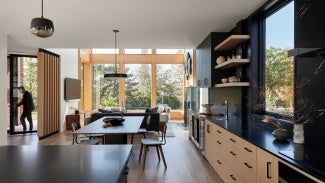
Setting the bar for a new neighborhood
In a St. Paul, Minn., community growing from a historic industrial site, inspiring architecture feels right at home. AIA partner Marvin provides a look.
The first Model T rolled off the production line at the Ford Motor Company’s brand-new plant in St. Paul in 1925. A century later, there’s a different kind of groundbreaking innovation coming to life on the plant’s former site: a new development known as Highland Bridge. And while the neighborhood taking shape there might be new, the ethos behind it echoes the city’s historical character as a dense, tight-knit community built around the scenic splendor of the Mississippi River.
As a longtime Twin Cities resident, architect David Strand, lead designer and principal at Strand Design, had a front-row seat for the transformation of the Ford site from 20th-century industrial complex to 21st-century community. When his clients chose him to design the new neighborhood’s first family home, he understood just what made it such a special place—and what attracted his clients to it.
“There are limited locations in the Twin Cities where you can be in this beautiful scenic setting and in these great surroundings and still have a single-family home, still walk to grocery stores, restaurants, bars, and playgrounds,” Strand explained. “I think that walkability mixed in with that setting was really what drew them there.”
Equally alluring to Strand was the challenge of setting the architectural bar for Highland Bridge with its first family home. Rising to meet that challenge required close collaboration with his clients, the builder, and the designer. It also required patience and persistence.
“I think we were all very aware, especially in this community, how long the project would be,” he said. “I think [my clients] chose someone that they could bear with for three years. And, you know, we’ve actually had a lot of fun.”
Setting the stage
The home sits on an idyllic spot along Mississippi River Boulevard, an undulating tree-lined parkway that follows the meandering course of the river and feeds into several popular beaches and parks, plus biking and hiking trails. For Strand and his team, this posed a challenge: how to make the most of the surrounding beauty while creating a space that offers privacy and functionality for a growing family.
The answer included expansive panes of glass in the public areas. For instance, in the living room, there are 10 of Marvin’s direct-glaze triple-pane units, each measuring roughly 5 feet by 8 1/2 feet. These offer sound dampening and energy efficiency while letting in light and scenery. Meanwhile, the more private kitchen, family, and office spaces have strategically placed windows. “We used the house to screen those more intimate areas, especially the primary suite,” Strand said. “We pushed [the main bedroom] to the back of the house and allowed the lower level of the home to screen and draw people’s attention.”
Walking from room to room, it’s intuitively clear that each part of the house has a role to play in the family’s everyday lives. Natural light illuminates and warms the open space of the living room area at the front. And while the living room is open to the kitchen, the home’s layout also shields that space and gives it a more intimate feel. Similarly, the more private spaces behind the open living room enjoy the same sunlight and scenic views but with a sense of privacy and seclusion. Taken together, the whole of the experience is much more than the sum of its parts.
For the exterior, bonderized metal and red brick echo the site’s industrial past and location in a historic residential area. “You see the brick of the Ford plant chimney that’s still there, and you think of all these other historic structures,” Strand said. “We really tried to integrate all those together in a way that in 20 years, when the trees are grown up and it’s a beautiful neighborhood, the house looks like it should be there.”
The completed home is a testament to Strand’s understanding of the neighborhood’s history and character, and of its future as more houses go up. It’s also an embodiment of his appreciation for the lives and experiences that his clients will enjoy within it—now and for decades to come.
“We wanted to make sure that the house stayed relevant in the future, as well, and that all those spaces were useful to their family and their lifestyle as the world evolves but also as their family grows and the kids get older,” Strand concluded. “It's just such a pleasant space to be in, a really energizing, positive, and bright space.”
For more information about windows and doors custom crafted to your vision, visit www.marvin.com.
AIA does not sponsor or endorse any enterprise, whether public or private, operated for profit. Further, no AIA officer, director, committee member, or employee, or any of its component organizations in his or her official capacity, is permitted to approve, sponsor, endorse, or do anything that may be deemed or construed to be an approval, sponsorship, or endorsement of any material of construction or any method or manner of handling, using, distributing, or dealing in any material or product.




